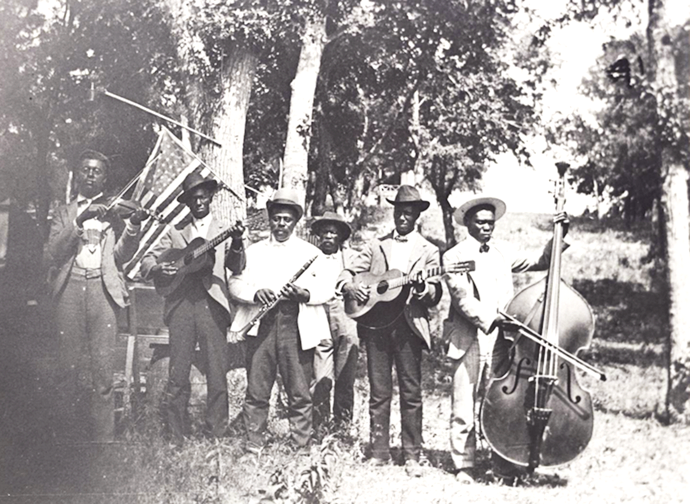June 19, 1900 in Texas: the band assembles for an Emancipation Day celebration.
Photo, by Grace Murray, from the North Texas State Library.
Juneteenth, 1865 and 2019
by Eric Jackson
Then
When did slavery end in the USA? There are various points of reference.
In many US jurisdictions it legally ended well before the Civil War.
In the history that most American kids are taught, it ended with the Emancipation Proclamation – but that was Abraham Lincoln’s military decree that only applied to slaves in the states that were in rebellion against the Union, not to such slave states that didn’t secede as Maryland, Kentucky and Missouri.
By lawyerly and other accounts it ended after the Civil War with the passage of the 13th Amendment, which prohibited involuntary servitude except when imposed by due process of law – but ask most competent jailhouse lawyers or many a black scholar and you are likely to be told of how the exception tended to become the rule in many cases with the advent of Jim Crow, then nearly a century later with the War on Drugs.
And then there was Juneteenth.
Texas seceded from the Union and sent troops to the serve in the Confederate Army, but very little of the Civil War’s combat took place in that state. After General Grant led the Union forces to a blood-soaked victory at Vicksburg the Mississippi came under complete Union control and those parts of the country in rebellion west of the river were cut off and, save for the overall naval blockade, largely ignored.
Texas was spared the grinding horror of trench warfare that Northern Virginia saw, and the incendiary devastation of General Sherman’s march through Georgia from Atlanta to the sea. Except for a small and static beachhead on the Gulf of Mexico the Grand Army of the Republic didn’t extend its lines into Texas. Unlike in other parts of the South, Texas slaves didn’t massively drop their tools and seek the protection of Abraham Lincoln’s troops. It was illegal to teach slaves to read and in any case the Texas press was de facto and de jure censored during the Civil War. Unlike many of their counterparts to the east, African-American slaves in Texas didn’t know that the Emancipation Proclamation had been decreed in early January of 1863.
By the middle of June in 1865, General Lee had surrendered the Army of Northern Virginia to General Grant at Appomattox Courthouse, Lincoln had been assassinated and federal troops were in Texas. However, a political decision had been made to let slavery linger just a bit, until that season’s cotton crop was in. But finally, on June 19th in Galveston, black slaves were gathered and the Emancipation Proclamation was read to them.
Texas is a big state and it took a little while for word to get out, but June 19th – Juneteenth – is taken in that state and among many African-Americans everywhere as the end of slavery. It’s a legal holiday in some US jurisdictions.
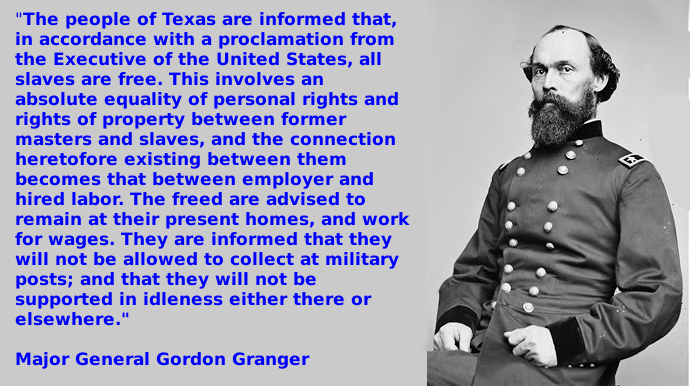
When General Granger issued this order, Texas, like the other former Confederate states, was under military occupation and martial law. In any case one of the common badges of slavey was a code of restrictions on black people traveling, to prevent both runaways and the organization of slave revolts. So if the US Army at that time forbade the movement of former slaves, it was not actually a new rule.
The context back then
Abraham Lincoln, like so many politicians before and since, had a personal story which for political purposes embellished certain aspects and downplayed others. He was “Honest Abe,” who as a young man made a living swinging an ax to split logs into rails and studied by candle light and then as an apprentice in a law firm to raise himself to a higher station in life. He was the brooding depressive, married to a difficult woman from a higher rung on the social-economic ladder, who managed his predicaments in ways that most probably helped him to better understand the woes of others.
By the time Lincoln rose to political prominence, he was a prosperous attorney with some important corporate clients. A single term in the US House of Representatives promised to end his political career once and for all because he was against the Mexican War, but it also attracted new and richer clients from among the growing Northern industrial interests to his law practice. In particular there were the railroad companies.
Lincoln disapproved of slavery but did not run for president on a platform of abolishing slavery. He ran to be steward of a bitterly divided country, as the man with a plan to stitch together this huge North American empire into a greater and more harmonious republic.
In particular, there was the railroads’ plan to do this by uniting the USA by a continental network of rails. At the time, the world had only one ocean-to-ocean railroad, the one built across Panama largely by West Indian laborers under the auspices of an American company. For the United States the plan was that railroad companies would get federal concessions across territories not then incorporated as states, with land not only to set down rails but also large rights-of-way to sell in order to establish farms and towns that would be natural customers for rail services. It was a monopolistic plan by men who later came to be known as prominent Robber Barons.
But the thing about the railroad companies’ plan was that it wasn’t too compatible with slavery’s spread to the west. It was about immigrants and poor families from the East establishing family farms and business centers to serve those farmers. The expansion of slave plantations along the tracks would give a planter class bargaining power with the railroads that small farmers and small businesses would not have. Given the habits of the planter aristocracy, it likely would have meant the unsustainable practice of exhausting the soil’s productivity and then abandoning it to repeat the process with as yet untilled land. Slavery’s spread meant limited population and limited business opportunities from the railroads’ perspective.
So Lincoln ran for the presidency opposing the western expansion of slavery. The problem with this was that the admission of new states in which slavery was prohibited would end the slave owners’ power in the US Senate. Before the Civil War the slave states had enough votes to block anything that needed a two-thirds supermajority to pass the Senate and, with a few Northern allies, could usually thwart anything inimical to plantation owners’ interests in that chamber of Congress. No matter that they represented states in which most white people didn’t own slaves and saw their economic aspirations hemmed in by the power of the slave-owning minority.
In an 1860 election in which Democrats split along section lines and among pro- and anti-slavery factions and the old compromising Whigs were extinct, Lincoln and the industrial interests carried the day via the Republican Party. The South moved to secede and Lincoln’s plans for a stewardship presidency gave way to a war presidency.
That war brought industrial power and economic aggression front and center. The Confederacy had more of a military culture and better generals, but the Union had a larger population and far more industrial might. More than 600,000 people died, with the Union taking the most casualties. The Industrial Age came to the old tactic of trench warfare, especially with the deployment of repeating rifles and Gatling guns.
The Confederates figured that their white men would put on gray uniforms and go fight the Yankees while slaves fed those armies. Black people had other ideas. They fled to Union lines en masse whenever possible. What the noted scholar and activist WEB Du Bois called a general strike added to the Union strategies.
The basic Northern strategy, once it became clear that secession was a serious threat, included a naval blockade of the South, Northern cavalry tearing up sections of Southern railroad tracks, control of the Mississippi and the burning of Atlanta and much of the rest of Georgia. But more was needed to collapse the Confederate economy.
Lincoln accelerated black flight from servitude with the 1863 Emancipation Proclamation, and as a lot of Northern white men were resisting the draft while all these black men were arriving in Union camps, began to enlist blacks into the Grand Army of the Republic. On the barrier islands of the Confederate East Coast the abolitionist hero of the Underground Railroad, Harriet Tubman, was put to work guiding Union soldiers from plantation to plantation, where they told the slaves that they were free and encouraged to them to leave the farms and granaries upon which the Southern armies depended barren and untended.
The Confederacy was crushed and its relatively untouched appendages like Texas fell with it. Even if, at war’s end, slaves were still picking cotton in the fields of Texas.
“Section 1. Neither slavery nor involuntary servitude, except as a punishment for crime whereof the party shall have been duly convicted, shall exist within the United States, or any place subject to their jurisdiction.
Section 2. Congress shall have power to enforce this article by appropriate legislation.”
13th Amendment to the US Constitution
ratified December 18, 1865
In the intervening more than a century and a half
The United States never did go back to chattel slavery as a matter of law, but there was a lot of backsliding. In the 1870s there arose the first iteration of the Ku Klux Klan, which had among its purposes an end to black voting, the withdrawal of federal occupation troops from the former Confederate States, the closure of such Reconstruction agencies as the Freedmen’s Bureau and the eviction of black farmers from lands redistributed to them in parts of the South during and after the war. The disputed election of 1876 featured widespread KKK terrorism and resulted in an agreement among white politicians to end Reconstruction.
There arose the Jim Crow system, wherein black people were disenfranchised, dispossessed, sent to prisons or chain gangs on often the most scurrilous of charges, and in many cases lynched across much of the South and in some Northern Klan strongholds like Indiana as well. The mean and ignorant white slave gang overseers gave way to a generation of mean and ignorant white chain gang guards.
Tiny cracks began to appear in that wall. Black educational institutions arose. The NAACP and other civil rights organizations were founded. A black intelligentsia, from the musicians of New Orleans to the writers of the Harlem Renaissance and far more widespread than that, arose to new prominence. Black nationalism arose and established international ties, with a man from Jamaica who had once practiced journalism in Panama, Marcus Garvey, as its most prominent US figure for a time. The conscription of African-Americans for the trench warfare of World War I introduced many of them to the African colonial subjects of Britain and France and fed into Pan-African sentiments.
But against that, and against all progress, after World War I there was a second iteration of the KKK. This time not only anti-black but also anti-immigrant, anti-Semitic and anti-Catholic. It was big in the states of the old Confederacy, but also had strongholds in the North, the most notorious but far from the only one being the state of Indiana.
That second wave of the Klan crashed on the realities of the 1930s and 1940s. The AFL unions had been mostly whites-only, but labor’s big upsurge was led by CIO unions that welcomed blacks. If Southern segregationists were part of Franklin D. Roosevelt’s New Deal coalition, influential voices like those of Labor Secretary Frances Perkins and first lady Eleanor Roosevelt insisted that the New Deal would not be only for whites.
As war clouds gathered, German agents, then without any legal requirement to register as such, worked the US press and the halls of Congress. And on the streets, the US affiliate of the Nazi Party, the German-American Bund, marched for white supremacy alongside the Ku Klux Klan.
World War II discredited racism. The horrific results of Nazi racial policies came into the glare of an international spotlight as the concentration camps were liberated one by one. President Harry Truman integrated the US Armed Forces. The color line broke down in Major League Baseball. Led by black religious figures and labor leaders, a new civil rights movement emerged.
There arose a third iteration of the KKK to oppose this, but their murders of civil rights activists and the brutality of police forces under their influence shocked the American conscience. The violent hatred and public rejection of it led to the signing, by a president from Texas, of the 1964 Civil Rights Act and the 1965 Voting Rights Act.
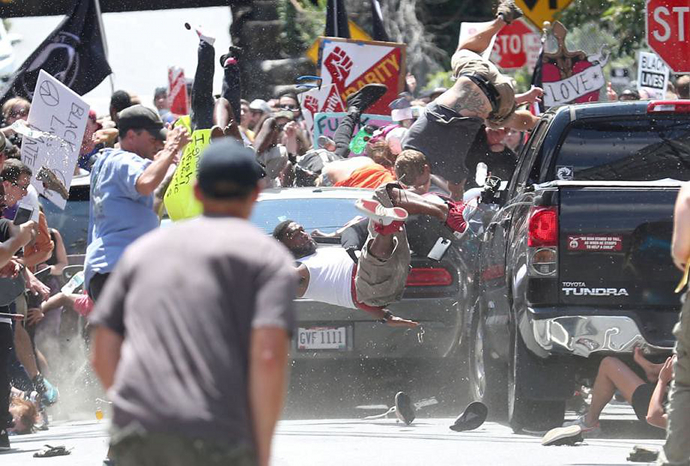
A neofascist rams his car into a crowd of anti-racist protesters in Charlottesville, Virginia on August 12, 2017. A woman was killed and several other people injured. In the wake of this Donald Trump said that some of the Nazis in Charlottesville were “fine people.” If somebody, as in 2016, tells African-Americans that it’s “woke” to abstain from voting when there is a white supremacist on the ballot, that argument is likely to get a more hostile reception than back then. Pulitzer Prize winning photo by Ryan Kelly.
The modern racist reaction
Then came Richard Nixon’s southern strategy, which ultimately shifted most white racists into the Republican Party. Nixon also began the “War on Drugs,” aimed largely at getting nonwhite people and hippies convicted on felony charges that would disqualify them from voting in many states.
Nixon’s disgrace was in some ways the crowning victory of the Black Power and antiwar movememts, but Watergate was really not their doing. In fact it was largely a process that unfolded when the enemies of black political power and peace activism, the circle of FBI leaders around the Machiavellian white supremacist J. Edgar Hoover, turned on Nixon because he had installed an outsider, a sleazy crook named L. Patrick Gray, to head the FBI after Hoover’s death. The leaks to The Washington Post by “Deep Throat,” much later identified as FBI administrator Mark Felt, were of information gleaned from FBI surveillance of the White House on Hoover’s shift.
Felt was no friend of progressives, and neither were the new breed of university administrators who arose after the campus revolts of the 1960s and early 1970s. Like Felt, the new caste was adept at pressing political buttons in which they didn’t believe, at exploiting the extremes of identity politics. Catch them lining their pockets at public expense and they were likely to find a way to call you a racist or a sexist. Should it have been a big surprise? After all, when Malcolm X was assassinated by a rival faction of black nationalists, two of his three bodyguards were undercover agents, one from the FBI and the other from the New York City Police Department.
The GOP shifted inexorably to the right over several decades, until in 2016 its winning ticket was headed by a white supremacist whose father had once been arrested in a KKK riot. There were serious milestones along the way, a big one the end of old concepts of bipartisan comity in the Congress starting in about 1994.
The 2016 Trump victory happened in large part due to low voter turnout, which in turn was promoted by online memes aimed at black people – sometimes originating in Russia – arguing that it’s somehow “woke” for African-Americans to abstain from voting.
There has never been such an indiscreet president of the United States as Donald Trump. His open calls for foreign intervention in US elections, made on the 2016 campaign trail and repeated as he prepares for the 2020 campaign, are unprecedented. Members of his campaign staff were convicted of violating the foreign agent registration laws that were passed to counter covert German lobbying. His declaration that there are “fine people” in the Nazi ranks shocked many.
Trump intends and has moved to transform America, with different particulars but in a similar sense to how such 20th century European fascists as Benito Mussolini, Adolf Hitler and Francisco Franco intended to transform their countries. He has gone a long way toward breaking up the Cold War alliances, economic “globalization” and old Washington customs.
There was a strong mid-term election reaction in 2018, but in the Georgia and Florida governors’ races vote suppression techniques helped white supremacists defeat black Democratic candidates.
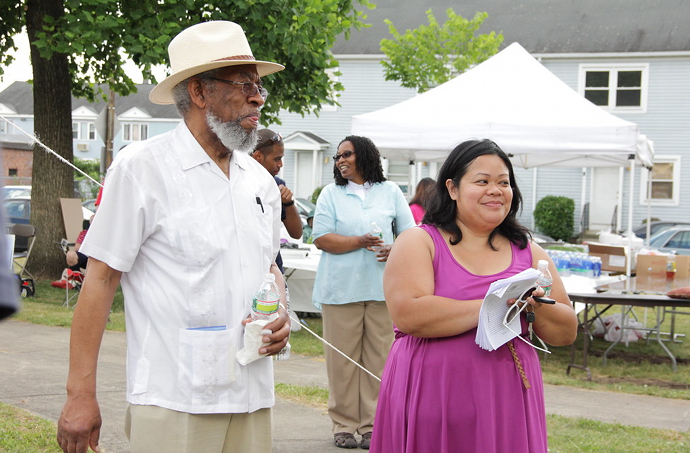
Juneteenth, 2012 in Springfield, Massachusetts. Photo by Amherst Media.
Gains, losses, fragmentation and missed opportunities of the Obama years
Abraham Lincoln’s initial intention was to preserve and heal the nation and to only gradually transform it through economic development. He intended his presidency to be an exercise in good stewardship.
Another president came from Illinois 168 years after Lincoln’s election. Like Lincoln, Barack Obama also took the reins of a deeply troubled nation, and saw himself as a steward rather than a transformer, a man dedicated to preserving the republic through modest, gradual changes.
A cabal of billionaire swindlers had, through leading economic institutions, marketed misrepresented mortgage-backed securities and the bubble burst in 2008. About one-third of the equity in the US economy was wiped off the books in an instant. The US financial superstructure and key industries like auto manufacturing were threatened.
Obama and the Democrats may not have had the votes in Congress to do otherwise, but they bailed out the bankers and industrialists while leaving the people who were being foreclosed and evicted to fend for themselves. Obama’s signature reform of the US health care system was left incomplete by its concessions to predatory insurance and pharmaceutical companies.
All the while, white racist extremism exploded in myriad ways. There was the “Birther” hoax, a white racist conspiracy theory promoted by among others Donald Trump, which holds that Obama isn’t and never was a US citizen. There was the Republican congressional wall against passage of any sort of immigration reform. There was a proliferation of extremist white militia groups and alt-right racist ideologies. There was a spike in racist violence, both by armed extremist civilians and by police who felt entitled to brutalize black people. Obama could be the steward who called for calm, understanding and public order. He went to great lengths to avoid being portrayed as an angry black man or as a transformational radical.
The antiwar candidate who bashed Hillary Clinton in the 2008 primaries for her vote for the Iraq War and promised to get America out of the conflicts in Afghanistan and Iraq instead led the country into disastrous new foreign interventions in Libya, Syria and by backing coups in Honduras and Ukraine. It was bound to demoralize and split the Democratic Party, and it did.
A Democratic establishment that had tried to avoid fundamental issues of economics, and of war and peace, found its discourses limited to identity politics. And even those appeals featured long silences.
Couldn’t talk about why there were all these Hondurans fleeing on foot into the United States. Couldn’t talk about the massacre of blacks in supposedly liberated Libya. Apart from universal horror at the atrocities by the minions of a wannabe caliph, Democrats couldn’t make a coherent case of why “our” jihadis in Syria were different and better than “their” jihadis.
Democrats could and did make belated and tepid acknowledgments that gays, lesbians, bisexuals and transgendered people have human rights that ought to be respected. But party leaders and candidates by and large wouldn’t talk about homophobia, sexism, anti-Semitism or countless other prejudices among core Democratic constituencies except to – often speciously – accuse insurgent candidates and their supporters of these things.
But the Republicans could and did touch some of those buttons. It was the bread and butter of the Russian online campaign.
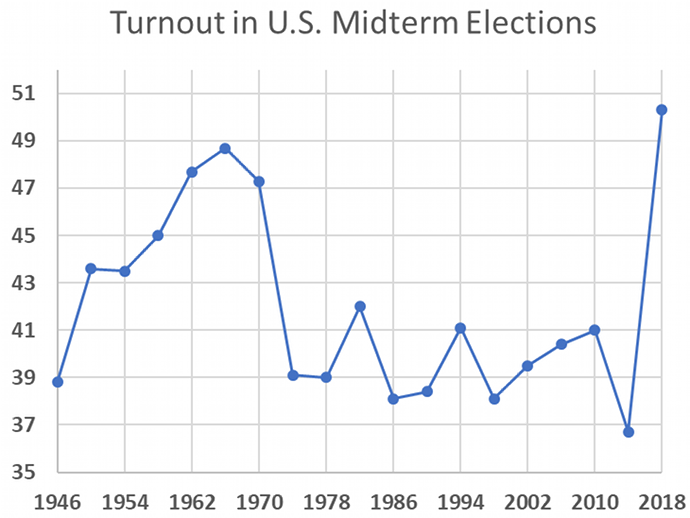
An awakening in progress. How many candidates, campaign workers and voter registars will be working Juneteenth crowds this year and next? Wikimedia chart.
Now
Now we are into the 2020 presidential election cycle, with some important state and local elections this year. What does Juneteenth mean in 2019?
It’s mostly a matter of how scant or full a measure of freedom African-American voters will accept. That decision will be made by black people largely in terms of whether and how they vote. White journalists, historians and activists will observe and comment along with their counterparts of other races. But black people will decide.
These links are interactive — click on the boxes

